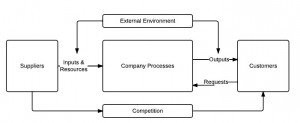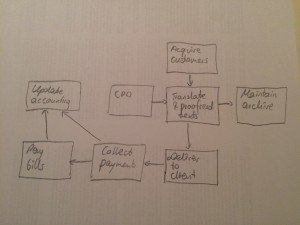
 Like many linguists, I really like studying and discovering new fields. It’s part and parcel of our job. What works really well with me is to set goals in my learning. And by that I don’t mean aspirational timelines or ephemeral end points, but real, concrete goals. Most of them take the form of official examination. I guess this is how I ended up with a certificate in IT and business analysis. In the past few weeks, I’ve been studying modelling business processes and of course, I took the exam today.
Like many linguists, I really like studying and discovering new fields. It’s part and parcel of our job. What works really well with me is to set goals in my learning. And by that I don’t mean aspirational timelines or ephemeral end points, but real, concrete goals. Most of them take the form of official examination. I guess this is how I ended up with a certificate in IT and business analysis. In the past few weeks, I’ve been studying modelling business processes and of course, I took the exam today.
As always when getting my hands on a new piece of business-related knowledge, I immediately think of ways to apply it to my business and by extension – to every freelancer’s business.
Seeing your translation business from the process perspective is exactly this: you recast your business as a set of processes that happen inside the business to deliver value to customers. To be able to do that, you need to identify your inputs, outputs, how they get transformed from one into another and your value proposition. But before we get into it, let’s take a step back and go through the steps of process mapping.
 At the highest level, any modelling exercise will involve looking at the context in which you operate. One of the tools I found most useful to grasp the context is Harmon’s alternative view of an organisation, see below.
At the highest level, any modelling exercise will involve looking at the context in which you operate. One of the tools I found most useful to grasp the context is Harmon’s alternative view of an organisation, see below.
In this view, you can see how your business relates to the external environment (and a very good idea in here is to conduct a PESTLE analysis!), but also you can map out your customers, competition and perhaps suppliers. Of course, the number of insights you get from this exercise will be plenty.
A step lower, you’re encouraged to draw a process map, which is an outline of processes that make up your business together with dependencies between them. In here you can see a rough draft of a process map of my business which I drew today.
What have I learned from it? Mapping my processes out has definitely helped me to realise that I need all of these elements to function properly as a business (ok, not that I didn’t realise this before – it reminded me of this fact). But I was definitely forced to think whether I was neglecting any of these core processes…
At an ever more granular level, process modelling gets down to documenting the flow of specific tasks within each process. Such a view, also called a swimlane diagram, outlines all actors, key decisions and business rules, as well as step by step tasks that need to happen for each project to finish.
I’ve just started drawing my swimlane for Acquire Customers from above. It will take me a while to document it, but I’ve already noticed some interesting elements, for example inefficient communication and handovers between me and my assistant and – the horror – bottlenecks that I was creating myself!
My next step will be to document the Translate and Proofread Texts process. Why do I think it’s important? I believe in documenting undocumented processes. This is how I do business and it’s important for me to be clear on the next step, but I can also use a process diagram to explain to clients how working with me looks like. That way I can also ensure consistency, especially when working with others. I can also look for potential problems or see how I can improve my customer service. If you work with others, documenting your processes is likely to improve collaboration and bring efficiency gains. Of course, my article barely scratches the surface here, but I gave you an idea and a few keywords to carry on researching.
MORE TRANSLATION VIDEO












